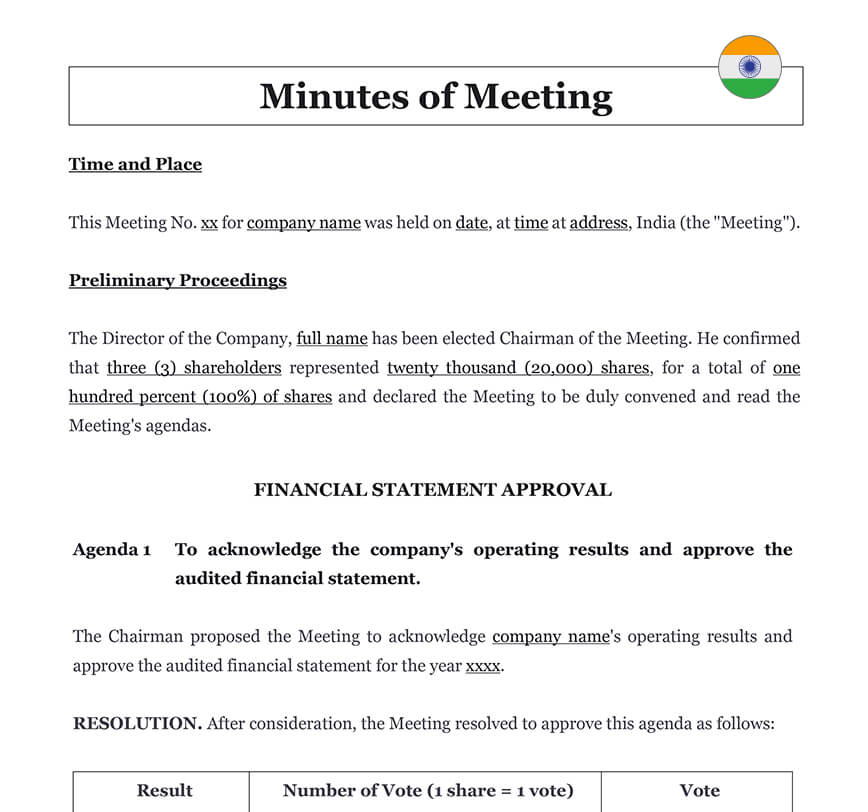Ready to use legal template
Drafted by experienced lawyers
Compliant with Indian law
Ready to use legal template
Drafted by lawyers
Compliant with Indian law
Home › Business contracts › Minutes of Meeting
Learn more about Minutes of Meeting in India
Minutes of Meeting (MoM) are official written records that capture the discussions, decisions, and action points agreed upon during a formal meeting. In India, maintaining accurate minutes is a crucial part of good corporate governance, especially for board meetings, annual general meetings, and other formal business gatherings. MoM provide legal documentation of what transpired, serve as a point of reference for future actions, and help ensure accountability among participants. They are often required for regulatory compliance under the Companies Act, 2013, particularly for companies, partnerships, and associations. Download our professionally prepared Minutes of Meeting template, drafted by legal experts in an easy-to-edit Word format, perfect for board meetings, shareholder meetings, or internal business discussions across India.
Table of contents
What is an Annual General Meeting (AGM)?
What is the difference between an AGM and an EGM?
What are Minutes of Meeting?
What is the purpose of this document?
Who can write the Minutes of Meeting?
When to write the Minutes of Meeting?
How to write Meeting Minutes?
Is it possible to correct this document afterwards?
What is an Annual General Meeting (AGM)?
The annual holding of the ordinary general meeting is a legal obligation. It takes place at the latest within 6 months after the end of the company’s fiscal year. During an AGM, the associates or shareholders of the company meet to review the annual accounts, discuss the past year, and establish future projects. Each approval decision is submitted to a vote of the partners.
What is the difference between an AGM and an EGM?
The difference between an ordinary and an extraordinary general meeting lies in the frequency of organization and the topics that are discussed. The organization of these two events remains, in the main, identical.
The extraordinary general meeting allows the shareholders of a company to be convened to address an urgent and major concern. It differs from the AGM, which is recurrent and allows to rule on the annual accounts. The agenda of an EGM does not deal with matters relating to the day-to-day management of the company but with a considerable and decisive change that has an impact on the company or its members.
What are Minutes of Meeting?
The minutes of a meeting are an official record of the proceedings of a meeting of the Board of Directors or an Annual General Meeting or any other meeting and the business transacted at the meeting. The minutes help in understanding the deliberations and decisions made at the meeting. All companies registered in India are required to keep minutes of all board and committee meetings in a minute book. There is no format or language restriction for recording meeting minutes.
What is the purpose of this document?
Minutes kept in accordance with the provisions of the Companies Act in India may be used as evidence in court. For example, the only way to prove that a resolution of the board of directors was passed at the meeting of the board of directors of the corporation is to produce the minutes in which the particular resolution was recorded in court.
Who can write Meeting Minutes?
In practice, the minutes can be drawn up by a secretary or any other employee whose responsibility it is. It is then a private document constituting a simple proof of the truthfulness of the information contained in the minutes of the ordinary general assembly. In short, the information contained in the minutes of the general meeting is considered as true until proven otherwise. To facilitate the procedure of the general assembly, it is preferable to be satisfied with a private document.
The minutes of the general assembly can also be drawn up on request by a public and ministerial officer in order to make it an authentic act constituting an irrefutable proof of the truthfulness of the information contained.
However, it is advisable to call upon a legal professional to ensure the conformity of the document provided for so that it is representative of the general meeting, and without ambiguity. The specialized lawyer can also attend the ordinary meeting in order to draw up the minutes immediately.
When to write the Minutes of Meeting?
It is a document that must be produced at the end of a GA, whether it is ordinary or extraordinary. Indeed, since it happens that the general assembly is the only moment when all the associates are gathered, it is essential to have the minutes signed immediately at the end of the meeting. The minutes are therefore drawn up and signed at the end of the meeting by the corporate officers, to which is attached an attendance sheet certifying the presence of the associates present. Each page of the minutes can be initialed by each partner when the company has few partners, but this is not an obligation. However, it is recommended that the partners initial the minutes of the AGM to avoid any later dispute about the content. The minutes must be signed in all cases and without exception by each decision-making member of the company.
How to write Minutes of Meeting?
Among the data which must absolutely appear in the minutes of a general assembly, it is necessary to specify the persons present and their functions, if certain associates were excused or not and the person who will represent them consequently during the phases of vote. The conclusions allowing the approval of the social accounts, the accounting results, the management report must appear. Also, it is at this moment that the sharing of the profits is evoked. Finally, the associates must confirm that they have given the powers to the corporate officer to use the minutes of the general assembly when he will proceed to the administrative formalities of the company.
In addition, the minutes of the general assembly must mention:
| ➤ The date and place of the meeting |
| ➤ The documents submitted for discussion are the company's accounts (profit and loss account, balance sheet, annex) and the management report |
| ➤ A summary of the debates which took place during the general meeting, if any |




